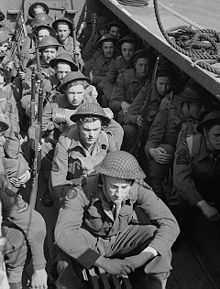Bardia raid
| ||||||||||||||||||||||||||||||
|
|
||||||||||||||||||||||||||||||
The Bardia raid was an amphibious landing at the coastal town of Bardia in North Africa by British Commandos over the night of 19/20 April 1941 during the Second World War. The raid was carried out by No. 7 Commando also known as A Battalion Layforce together with a small detachment from the Royal Tank Regiment supported by five navy ships and a submarine.
The raid—which destroyed an Italian artillery battery and a supply dump—was deemed a success despite the loss of 71 men. The more lasting strategic effect of the raid was the diversion of a German armoured brigade from the front line to provide rear area security.
Background
In January 1941, an ad hoc force of 2,000 commandos—known as Layforce—was sent from Great Britain to take part in raiding operations in the Mediterranean.[1] Under the command of Colonel Robert Laycock, the force comprised No. 7, No. 8, No. 11 Commandos, a troop from No. 3 Commando and the Folbot section. On their arrival in Egypt in March 1941, the force was strengthened by the amalgamated No. 50 and No. 52 Commandos. To avoid the Axis powers becoming aware that a large force of commandos had arrived in theatre, 7, 8, 11 and 50/52 Commandos became known as A, B, C and D Battalions Layforce.[2][3]
After the German Operation Sonnenblume offensive in North Africa by the Afrika Korps which re-occupied Cyrenaica, Sollum and Bardia in February 1941 and the invasions of Greece and Yugoslavia in April 1941, the plans for the deployment of Layforce were changed and their first operation would be a raid on Bardia.[1]
Raid
The Bardia raid was planned for the night of 19/20 April by A Battalion Layforce, with the objective of disrupting enemy lines of communication and inflicting as much damage as possible to installations and equipment. The plan called for the simultaneous landing of A Battalion and a troop of tanks from the Royal Tank Regiment on four beaches by Landing Craft Assault (LCA). The landing force would be transported to the area by HMS Glengyle, escorted by the anti-aircraft cruiser HMS Coventry and the destroyers HMAS Stuart, Voyager and Waterhen.[4] On arrival of the transports off Bardia, one LCA could not be lowered and there were difficulties releasing the others. When they did get going and approached the beaches, they were expecting to see lights to guide them in, which were to have been deployed by the Folbot section; unknowingly, the Folbot section had been delayed en route when friendly fire caused the submarine transporting them—HMS Triumph—to submerge and take evasive action.

The main landing force—now behind schedule—were landed on the wrong beaches.[5] All the landings, however, were unopposed and the commandos made their way inland to locate and destroy the objectives they had been assigned. The town of Bardia was found to be unoccupied by the Italian or German forces, and faulty intelligence before the mission resulted in some objectives being missed, as they were not where they were supposed to be, or they did not even exist. The commandos, however, did manage to find and destroy an Italian supply dump and an Italian coastal artillery battery before returning to their waiting LCA′s to reembark. The raid would have passed without any loss to the commandos but for the death of a commando officer by friendly fire from an overalert commando soldier and the capture of 70 men who, after getting lost, ended up on the wrong evacuation beach and became prisoners of war.[5]
Aftermath
The raid on Bardia was a considerable strategic success. Alarmed by it, the Germans diverted the greater part of an armoured brigade from Sollum, where it was beginning to exert heavy pressure on the Western Desert Force, and kept it for some time in the rear areas.[6]
Layforce—instead of being used as a commando raiding unit—were deployed as normal infantry battalions, a role for which they were neither equipped nor trained. As one of the few reserve forces available, they were sent to take part in the Battle of Crete; fighting as the rearguard they lost 600 men before being evacuated.[7] Layforce C Battalion was not sent to Crete but instead to Lebanon, where they lost over 120 men fighting in the battle of the Litani River.[5] The steady drain of manpower without the re-supply chain of normal British Army regiments meant that Layforce as a unit was left in an ineffective state and was disbanded in July 1941.[8]
The author Evelyn Waugh—who took part in the raid—related in an article he wrote for Life Magazine in November 1941 that the Germans "sent a strong detachment of tanks and armoured cars to repel the imagined invasion". However, in his personal diary published in 1976, a very different picture emerged of incompetent execution by the commandos against virtually no opposition.[9]
References
- Aitchison, Jean; Lewis, Diana M. (2003). "Reportage, literature and willed credulity by John Carey". New Media Language. Routledge. ISBN 0-415-28303-5.
- Chappell, Mike (1996). Army Commandos 1940–1945. Elite Series # 64. London: Osprey Publishing. ISBN 1-85532-579-9.
- Mountbatten, Louis (2007). Combined Operations: The Official Story of the Commandos. Read Books. ISBN 1-4067-5957-0.
- Saunders, Hilary St. George (1959) [1949]. The Green Beret: The Commandos at War. London: Four Square Books.
External links
| ||||||||||||||||||||||||||||||||||||||||||||||||||||||||||||||
